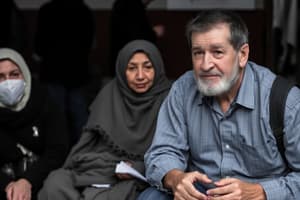Podcast
Questions and Answers
Which of the following is a significant factor contributing to the digital divide experienced by rural and remote families?
Which of the following is a significant factor contributing to the digital divide experienced by rural and remote families?
- Poor internet infrastructure and connectivity. (correct)
- Government restrictions on internet usage.
- Lack of interest in technology among rural residents.
- Limited access to social media platforms.
The Royal Flying Doctor Service (RFDS) primarily focuses on providing financial aid to rural and remote families.
The Royal Flying Doctor Service (RFDS) primarily focuses on providing financial aid to rural and remote families.
False (B)
Name one factor (besides geographical isolation) that significantly hinders homeless people's access to essential services.
Name one factor (besides geographical isolation) that significantly hinders homeless people's access to essential services.
Financial constraints / Lack of income
_______ is a key support service offering free laundry and shower facilities to homeless individuals, promoting hygiene and dignity.
_______ is a key support service offering free laundry and shower facilities to homeless individuals, promoting hygiene and dignity.
Match the following support services with the primary group they serve:
Match the following support services with the primary group they serve:
What is a crucial equity issue faced by people with disabilities that the NDIS aims to address?
What is a crucial equity issue faced by people with disabilities that the NDIS aims to address?
Youth Off The Streets primarily focuses on providing financial assistance to young people.
Youth Off The Streets primarily focuses on providing financial assistance to young people.
Name one specific strategy to improve educational outcomes for youth from disadvantaged backgrounds.
Name one specific strategy to improve educational outcomes for youth from disadvantaged backgrounds.
A significant challenge faced by rural and remote families is the high cost of living, including ________ which are often more expensive than in urban areas.
A significant challenge faced by rural and remote families is the high cost of living, including ________ which are often more expensive than in urban areas.
Which organization provides 24/7 crisis support for youth facing challenges?
Which organization provides 24/7 crisis support for youth facing challenges?
Homelessness and the lack of stable housing do not affect school attendance for youth.
Homelessness and the lack of stable housing do not affect school attendance for youth.
What type of government support is vital for rural and remote families, especially during challenging times like droughts or floods?
What type of government support is vital for rural and remote families, especially during challenging times like droughts or floods?
To address economic hardship among homeless people, providing _______ programs and financial literacy training is essential.
To address economic hardship among homeless people, providing _______ programs and financial literacy training is essential.
Which of the following is a strategy to create positive social environments for people with disabilities?
Which of the following is a strategy to create positive social environments for people with disabilities?
Men's Sheds and local volunteer groups offer social support and community connections for homeless people.
Men's Sheds and local volunteer groups offer social support and community connections for homeless people.
Name a way to improve access to services for people with disabilities, particularly in regards to transportation.
Name a way to improve access to services for people with disabilities, particularly in regards to transportation.
To combat health inequality in rural areas, expanding _______ options can ensure that residents have access to medical consultations and advice.
To combat health inequality in rural areas, expanding _______ options can ensure that residents have access to medical consultations and advice.
Which service addresses mental health issues and potential drug use among the youth?
Which service addresses mental health issues and potential drug use among the youth?
Increased NDIS funding and improved accessibility are key solutions for addressing economic hardship faced by people with disabilities.
Increased NDIS funding and improved accessibility are key solutions for addressing economic hardship faced by people with disabilities.
Besides job training, what kind of courses can help homeless people improve their employment prospects and financial stability?
Besides job training, what kind of courses can help homeless people improve their employment prospects and financial stability?
To provide better education opportunities to children in rural and remote locations, _______ can facilitate distance learning.
To provide better education opportunities to children in rural and remote locations, _______ can facilitate distance learning.
Which challenge do young Australians face in regards to employment?
Which challenge do young Australians face in regards to employment?
Salvation Army Employment Plus mainly supports rural and remote families.
Salvation Army Employment Plus mainly supports rural and remote families.
What type of initiative would help the youth to avoid school dropouts?
What type of initiative would help the youth to avoid school dropouts?
In what area does the eSafety Commissioner provide support to youth?
In what area does the eSafety Commissioner provide support to youth?
Flashcards
Prevalence of Rural & Remote Families
Prevalence of Rural & Remote Families
Approximately 28% of Australians reside in rural or remote areas.
Diversity within Rural & Remote Families
Diversity within Rural & Remote Families
Farmers, Indigenous communities, small-town residents, and mining families are included.
Prevalence of Homelessness
Prevalence of Homelessness
Around 122,000 individuals in Australia are experiencing homelessness (ABS 2021).
Diversity within Homeless Populations
Diversity within Homeless Populations
Signup and view all the flashcards
Prevalence of Youth (12-24)
Prevalence of Youth (12-24)
Signup and view all the flashcards
Diversity within Youth
Diversity within Youth
Signup and view all the flashcards
Prevalence of People with Disabilities
Prevalence of People with Disabilities
Signup and view all the flashcards
Diversity of Disabilities
Diversity of Disabilities
Signup and view all the flashcards
Health Challenges in Rural Areas
Health Challenges in Rural Areas
Signup and view all the flashcards
RFDS
RFDS
Signup and view all the flashcards
Housing Needs of Homeless People
Housing Needs of Homeless People
Signup and view all the flashcards
Mission Australia's Role
Mission Australia's Role
Signup and view all the flashcards
Housing Issues for Youth
Housing Issues for Youth
Signup and view all the flashcards
Youth Refuge NSW
Youth Refuge NSW
Signup and view all the flashcards
Housing Needs of People with Disabilities
Housing Needs of People with Disabilities
Signup and view all the flashcards
NDIS Home Modifications
NDIS Home Modifications
Signup and view all the flashcards
Health Issues for Homeless People
Health Issues for Homeless People
Signup and view all the flashcards
Street Medics
Street Medics
Signup and view all the flashcards
Youth Health Issues
Youth Health Issues
Signup and view all the flashcards
Headspace's Role
Headspace's Role
Signup and view all the flashcards
Healthcare Challenges for People with Disabilities
Healthcare Challenges for People with Disabilities
Signup and view all the flashcards
NDIS
NDIS
Signup and view all the flashcards
Rural & Remote Employment Challenges
Rural & Remote Employment Challenges
Signup and view all the flashcards
Farm Household Allowance
Farm Household Allowance
Signup and view all the flashcards
Employment Issues for Homeless People
Employment Issues for Homeless People
Signup and view all the flashcards
Study Notes
- These notes cover four groups: Rural & Remote Families, Homeless People, Youth, and People with Disabilities.
- The notes focus on prevalence, needs, access to services, equity issues, and support services for each group.
Prevalence & Diversity
- Approximately 28% of Australians reside in rural or remote areas.
- Rural & Remote families include farmers, Indigenous communities, small-town residents, and mining families.
- Around 122,000 Australians are homeless, as per the ABS 2021 data.
- Homeless people include rough sleepers, couch surfers, and those in crisis accommodation.
- Approximately 4.2 million youth (12-24 years old) live in Australia.
- The youth demographic includes students, young workers, at-risk youth, and LGBTQ+ youth.
- About 4.4 million Australians (around 18% of the population) have disabilities.
- The disabilities included are physical, intellectual, sensory, and psychosocial.
Satisfaction of Needs
- Rural & Remote Families face expensive food and clothing, and housing shortages.
- Rural Aid service addresses the needs for food, clothing and shelter for Rural & Remote Families
- Homeless People face a lack of secure housing, impacting their access to food, clothing and shelter.
- Mission Australia provides support for food, clothing and shelter for homeless people.
- Youth experience youth homelessness and housing affordability issues.
- Youth Refuge NSW offers support for the food, clothing and shelter needs of young people.
- People with Disabilities may have inaccessible housing and a lack of home modifications.
- NDIS Home Modifications service helps People with Disabilities address the food, clothing and shelter needs of People with Disabilities.
- Rural & Remote Families have limited access to hospitals and face doctor shortages, impacting health.
- Royal Flying Doctor Service (RFDS) helps address the health needs of rural and remote families.
- Homeless People experience poor health and lack of Medicare access
- Street Medics addresses the health needs of homeless people
- Youth deal with mental health issues and drug use that influences their health
- Headspace addresses the health needs of young people
- People with disabilities face expensive healthcare and specialist shortages.
- NDIS supports the health needs for people with disabilities.
- Rural & Remote Families have fewer schools and long travel times to go to school.
- School of the Air helps to address the education needs of people living in rural/remote areas.
- Homeless People experience poor school attendance and instability that affects their education
- Youth Off The Streets assist this population in addressing their education needs
- Youth can struggle with bullying and school dropout risk.
- Beyond Blue Youth Support assists in the education needs of young people.
- People with Disabilities lack accessible schools and resources.
- Disability Support in Schools help address the education needs of people with disabilities.
- Rural & Remote Families face seasonal work and few job options.
- Farm Household Allowance addresses employment for rural and remote families.
- Homeless People experience unstable work and discrimination.
- Salvation Army Employment Plus assists homeless people with their employment needs.
- Youth face high unemployment and job inexperience.
- JobActive for Youth assists youth with their employment needs
- People with Disabilities face workplace discrimination and inaccessibility.
- JobAccess (Disability Employment Services) helps people with disabilities to address their employment needs.
- Rural & Remote Families are at risk of bushfires, floods, and domestic violence, which can impact their safety and security.
- NSW Rural Fire Service assists rural and remote families with their safety and security needs.
- Homeless People are at higher risk of assault and abuse.
- Domestic Violence Shelters assist homeless people with their safety and security needs
- Youth are subject to cyberbullying and street violence.
- eSafety Commissioner assists young people with their safety and security needs
- People with Disabilities can face abuse, neglect, and discrimination.
- Disability Advocacy Services can assist people with disabilities with their need for safety and security.
- Rural & Remote Families may experience social isolation and cultural disconnection.
- Country Women’s Association assists rural and remote families with their sense of identity.
- Homeless People experience loss of dignity and disconnection.
- Orange Sky Laundry assists homeless people with their need for a sense of identity.
- Youth commonly struggle with peer pressure and identity issues.
- Kids Helpline assists young people in addressing and building their sense of identity
- People with Disabilities can face social exclusion and stigma.
- Disability Peer Support Groups help people with disabilities address issues with their sense of identity.
Access to Services
- Geographic isolation affects access for Rural & Remote Families due to long travel times and limited transport.
- Homeless People encounter mobility barriers as a result of having no fixed address.
- Youth face poor transport access, particularly those in rural areas.
- People with Disabilities experience a lack of accessible transport options.
- Financial constraints affect Rural & Remote Families due to the high cost of living and healthcare.
- Homeless People have no income and rely on charities.
- Youth face casual work and a high cost of living.
- People with Disabilities experience unemployment and the high cost of assistive devices.
- Technology barriers affect Rural & Remote Families because of poor internet and fewer telehealth options.
- Homeless People lack phone or internet access for online services.
- Digital literacy and online safety are technology barriers for young people.
- Assistive technology is expensive or unavailable for People with Disabilities.
- Awareness & Stigma: Self-reliance culture and lack of outreach affect Rural & Remote Families.
- Homelessness stigma prevents help-seeking.
- Youth mistrust authority and fear judgement.
- Disability stigma, limited inclusive services prevent People with Disabilities from getting help.
Improving Access
- Increased telehealth, mobile clinics, and education funding for Rural & Remote Families.
- More crisis accommodation, social programs, and job training for Homeless People.
- Increased mental health resources and school engagement programs for Youth.
- Increased NDIS funding, accessibility laws, and job support for People with Disabilities.
Creating Positive Social Environments
- Government Support: Infrastructure funding and farm subsidies for Rural & Remote Families.
- More public housing and rent assistance for Homeless People.
- Education & job subsidies for youth.
- NDIS, disability support pension for People with Disabilities.
- Community Networks include Men’s Sheds, local volunteer groups for Rural & Remote Families.
- Homeless shelters and outreach programs for Homeless People.
- Youth groups and mentorship programs for Youth.
- Disability advocacy groups and peer networks for People with Disabilities.
- Mental Health Support: Rural counselling and suicide prevention for Rural & Remote Families.
- More crisis counselling and addiction support for Homeless People.
- Youth mental health programs for Youth.
- Accessible mental health services for People with Disabilities.
- Employment & Education: More scholarships, rural job incentives for Rural & Remote Families.
- Job training, financial literacy courses for Homeless People.
- Traineeships, apprenticeships for Youth.
- Disability employment support for People with Disabilities.
Equity Issues & Strategies
- Health Inequality solutions include expanding telehealth & rural doctor incentives for Rural & Remote Families.
- More free clinics & mobile health services are needed for Homeless People.
- Increased youth mental health funding.
- Increase NDIS funding & accessibility for People with Disabilities.
- Education Disadvantage solutions include more distance learning & scholarships for Rural & Remote Families.
- More youth education & crisis support is needed for Homeless People.
- Better school engagement programs for Youth.
- More inclusive schools & disability funding are needed for People with Disabilities.
- Economic Hardship solutions include financial aid, business grants, drought relief for Rural & Remote Families.
- Employment programs & financial literacy training for Homeless People.
- Increased youth employment initiatives are needed.
- More workplace accommodations & job support for People with Disabilities.
- Housing Crisis solutions include more affordable rural housing projects for Rural & Remote Families.
- Increased public housing & crisis shelters for Homeless People.
- More affordable youth accommodation is needed.
- Accessible housing & financial aid for People with Disabilities.
Key Support Services for Each Group
-
Royal Flying Doctor Service (RFDS) provides emergency medical care for rural and remote families.
-
Rural Aid offers drought relief and financial aid for rural and remote families.
-
School of the Air provides distance learning services for rural and remote families.
-
Country Women’s Association (CWA) offers social support for rural and remote families.
-
Mission Australia provides housing and food support for homeless people.
-
Orange Sky Laundry offers free laundry & showers for homeless people.
-
Street Medics provides mobile healthcare for homeless people.
-
Headspace provides youth mental health services.
-
Kids Helpline offers 24/7 crisis support for youth.
-
Youth Off The Streets provides education & housing support for youth.
-
NDIS provides funding for disability services.
-
JobAccess offers disability employment support.
-
Vision Australia provides support for visually impaired people.
Studying That Suits You
Use AI to generate personalized quizzes and flashcards to suit your learning preferences.




